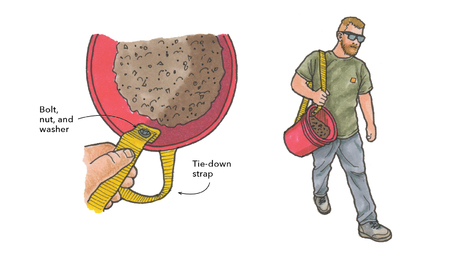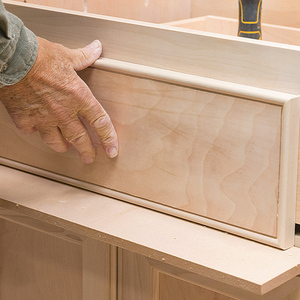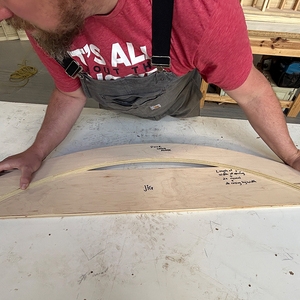Need some professional unbiased (not a salesman) opinion on using a Semi-gloss LATEX vs Semi-gloss OIL based paint on trim. Remodel job has new wood and old previously painted trim. I understand Latex has come a long way (improved). Is the finished product (durability, finish, etc) just as good as the oil based? Thanks.
Discussion Forum
Discussion Forum
Up Next
Video Shorts
Featured Story

Add a strap for easy carrying and pouring when working with 5-gal. buckets.
Featured Video
How to Install Exterior Window TrimHighlights
"I have learned so much thanks to the searchable articles on the FHB website. I can confidently say that I expect to be a life-long subscriber." - M.K.
Fine Homebuilding Magazine
- Home Group
- Antique Trader
- Arts & Crafts Homes
- Bank Note Reporter
- Cabin Life
- Cuisine at Home
- Fine Gardening
- Fine Woodworking
- Green Building Advisor
- Garden Gate
- Horticulture
- Keep Craft Alive
- Log Home Living
- Military Trader/Vehicles
- Numismatic News
- Numismaster
- Old Cars Weekly
- Old House Journal
- Period Homes
- Popular Woodworking
- Script
- ShopNotes
- Sports Collectors Digest
- Threads
- Timber Home Living
- Traditional Building
- Woodsmith
- World Coin News
- Writer's Digest


















Replies
I believe it is. Oil traditionally settles out better than latex and is harder ultimately, but the new higher end latex semi-gloss paints when mixed with an additive like Flotril will give you just as good a finish, is durable and will last. Latex is easier to work with and cleans up easy, plus there's no bad fumes.
I couldn't have said all this 20 or even 10 years ago, the high end painters all used oil then, but that's not so much the case anymore.
True, but latex exterior primer still sucks.
If your view never changes you're following the wrong leader
I had been using Ben Moore paint and asked at the paint store if they had a better primer than that. They recommended California primer which I have now used for the past two years. One way I evaluate primer is to notice how difficult it is to wash dried primer off of my hands. If this is a valid evaluation technique, California latex primer is way better.
I generally don't use latex primer. Depends on what you're applying to.
Thanks for all of the discussion. Does the Flotril additive do more than just make it go on better or does it also make the finish more durable/harder? Is it necessary or recommended to use the same brand primer ie, use Porter paints primer for a Porter paint final paints? Does anybody have strong opinion of brands. I believe I remember Consumer Reports rating Behr paints high on their list.
As the name implies, the Flotril makes it easier to work with and the finish will settle out better. I don't think it makes it more durable or harder.It's funny, The HD paints (Behr) were such #### for the longest time. Glidden must have reformulated. I'm a little skittish to try it. My favorite brand to date is MAB which is a more local product for this area. It's better than Moore.
I have always used latex for walls and ceiling and oil for the trim - especially doors and windows.
The reason I prefer oil for the doors / windows - I am a hopelessly slow painter, and in order to maintain a "wet edge" along all of the panels etc I have always used oil. Does Flotril (Flotrol?) lengthen the "skin" time or does it just help with leveling properties?
I do not paint for customers and tell them that right up front. I will prime for customers - new drywall and trim (on sawhorses, before it is hung; then touch up any nail filler, etc.)
I am very opinionated on primer - Benjamin Moore Fresh Start - latex. Goes on easily, interior / exterior, dries fast and most importantly it is sandable. When the primer coat shows a tool mark or bubbles in DW compound, you can fill right over top of the primer and then touch up the repair - does not clog up the sandpaper like other brands which seem to remain slightly sticky on the surface.
Jim
Never underestimate the value of a sharp pencil or good light.
Edited 9/22/2007 11:11 am ET by JTC1
Floetrol will not make it harder. It will help with a wet edge and flow out.
Consumer reports also gave a great review to lowes paint. I am a huge fan of sherwin williams line of products. A job I recently finished, the HO wanted to use Lowes paint ( I believe because of the CR review). I begrudgingly agreed. It was the worst paint I have ever used ( 25 years of painting proffessionally). CR is now on the list of things I will never use right next to Lowes paint - Valspar.
Remodeling Contractor just on the other side of the Glass City
Biggest complaint with "latex" is
that it cannot be sanded.
That used to be true.
It's amazing how manageable the higher quality latexes are now.
Also enamels would be sandable after an entended period but were a comparable biatch in the short term.Remodeling Contractor just on the other side of the Glass City
"Biggest complaint with "latex" isthat it cannot be sanded."
Until recently I used only oil-base paint. But on my last couple trim projects I tried Sherwin Williams "Proclassic" waterborne interior acrylic gloss enamel.
I found it was easily sandable ... which was good because after my first coat a few drips had formed after I thought it was brushed smooth.
The short open time was a challenge, but can be lengthened with an additive. Overall, I found the advertised "flow and leveling characteristics (that) result in a smooth, rich finish equal to an alkyd enamel" is accurate.
Allen
One draw-back to latex paint is that it can stick to the rubber weather stripping around windows and doors. So you might want to use oils in those situations where you need a hard, non-stick surface. Unless somebody in this forum has a latex solution for this, too.
It's becoming a moot issue though. In my state (Maryland) you cannot even buy oils in cans bigger than quarts anymore.
" In my state (Maryland) you cannot even buy oils in cans bigger than quarts anymore."Same here in Pa.
skh,
I would never use latex on trim. Latex is rubber. Unless it's baked like on the underside of roof sheathing at the eaves, it won't get hard like oil. I have seen over and over the use of latex on cupboards and trim around doors, windows, etc and it is too easily chipped or scratched. Latex is great for walls.
Flotrol does improve the leveling of a latex but not that much, it is useful in getting latex through a sprayer and slowing the drying. If you want a glass smooth paint finish with a brush, try any oil based paint by Ben Moore. I've never seen anything flatten out like that. I painted in the mpls area for 8 years and all the older houses I worked in with wood trim were painted with BM Satin Impervo. I tried many other local and national brands and nothing came close.
I'm not some huge BM nut ($$) but when you expend the effort to build and prepare something beautiful, painting it could either make it a masterpiece or destroy it and I've seen plenty of both. It matters what you use for paint. Before committing to anything buy a quart of BMSI and try it out.
- r
"I would never use latex on trim. Latex is rubber."BS!"Main Entry: la·tex
Pronunciation: 'lA-"teks
Function: noun
Inflected Form(s): plural la·ti·ces /'lA-t&-"sEz, 'la- /; or la·tex·es
Etymology: New Latin latic-, latex, from Latin, fluid
1 : a milky usually white fluid that is produced by cells of various seed plants (as of the milkweed, spurge, and poppy families) and is the source of rubber, gutta-percha, chicle, and balata
2 : a water emulsion of a synthetic rubber or plastic obtained by polymerization and used especially in coatings (as paint) and adhesives'It is called LATEX because it is an EMULSION, not be cause it is made from rubber.In the UK the common name is Emulsion Paints instead of Latex Paints.And even if it was made from rubber so what? It is an ingredient.While I doubt that you would want to put sodium or chorlide on you food many people use those as INGEDIENTS in cooking or at them at the table..
.
A-holes. Hey every group has to have one. And I have been elected to be the one. I should make that my tagline.
"a water emulsion of a synthetic rubber"
Geeze, Bill, you even said it yourself. Once the water evaporates from the emulsion what's left is rubber.
The point being simply that latex paint, enamel or whatever is not as durable as oil based paint.
Oil is certainly a pain in the neck to work with but use it where it counts and the payoff is more than worth the trouble. Would you paint your car with latex? The leveling property of BM paint combined with the durability make oil the obvious choice for woodwork.
- r
It is amazing how you cut off the quote."a water emulsion ... or plastic obtained by polymerization and used especially in coatings (as paint) and adhesives'"Once the water evaporates from the emulsion what's left is rubber."First of all when the water evaporates you still don't have "paint".For about 4 weeks the polymerization continues until you have the final coating." Would you paint your car with latex?"I certainly don't want to an oil based interior enamael either.But I would use acrylic coatings.There are valid reason why some people prefer oil and others prefer a latex paint.But because one is made from "rubber" or not is not one of them..
.
A-holes. Hey every group has to have one. And I have been elected to be the one. I should make that my tagline.
I would have to check this is a WAG.
I would believe that alot of cars are actually coated with a WB.
Body shops don't follow suit.Remodeling Contractor just on the other side of the Glass City
Yes, Detroit has been using water-based lacquer for about 30 years now.
If your view never changes you're following the wrong leader
Thanks.
I thought so but didn't want to put myself out there so far.Remodeling Contractor just on the other side of the Glass City
Before I posted that I several acrylic coatingsOne is a clearcoat dry POWDER. That does not have any solvents at all.Another is a unrethane reinforced acrylic. And the last an acrylic "lacquer". Now because that use the lacquer in it does not mean that it contains any lacquer thinner as the base solvent.But I never tried looking up the spec sheets, tech sheets, or MSDS to get the details.My point is that just becasue it has a name on it does really mean anything, even assuming that the name is "acurate". Latex, in this case, just means that process by which the paint is manufactured..
.
A-holes. Hey every group has to have one. And I have been elected to be the one. I should make that my tagline.
That used to be the case.
It is not anymore.
Remodeling Contractor just on the other side of the Glass City
Oil paint has some tendancy to yellow over time.
http://www.benjaminmoore.com/bmpsweb/portals/bmps.portal?_nfpb=true&_windowLabel=contentrenderer_1_9&contentrenderer_1_9_actionOverride=%2Fbm%2Fcms%2FContentRenderer%2FrenderContent&contentrenderer_1_9WT.svl=2&contentrenderer_1_9currentNodeUUID=%2FBEA+Repository%2F48088&contentrenderer_1_9NodeUUID=%2FBEA+Repository%2F48076&_pageLabel=fc_businessresources
Still, I think Ben Moore Satin impervo is a great product (and still available by the gallon here in Vermont).
Rich
Tendancy?
That is the understatement of the last two centuries.
It is GUARANTEED to yellow or " color shift"Remodeling Contractor just on the other side of the Glass City
I was once in a factory where they dipped their product before baking it. I said the word 'paint' ... and all conversation STOPPED. Sort of like the E>F>Hutton commercial. We don't "paint," I was told, we apply a "coating." OK. Sorry :D
The fact is, "paint" isn't what it used to be. Try to make it a 'latex vs. oil' argument is silly .... not only are there other types of paint (such as epoxy), but there is a tremendous variation between types.
Let me use an example. Many have posted, recommending the use of oil based paint for trim - but NONE have recommended Rust-o-leum. There's a reason for that; Rust-o-leum is designed for metal, and rust prevention. As a paint, it is fairly soft. There are likely many latex paints that would out-perform Rust-o-leum on trim work.
Far more critical than the paint chosen are the painting conditions. Preparation, and cleanliness, are key. If you do plan upon an oil based paint, a shellac based primer is critical. Dry wood is essential as well.
Once the paint is on, it needs to be protected while it cures. Not just until it's dry to the touch - until it cures. This can be another week. During this period, you will be able to see a quality paint smooth and level itself, to a fine shine .... if you let it!
" The fact is, "paint" isn't what it used to be. Try to make it a 'latex vs. oil' argument is silly .... not only are there other types of paint (such as epoxy), but there is a tremendous variation between types.Let me use an example. Many have posted, recommending the use of oil based paint for trim - but NONE have recommended Rust-o-leum. There's a reason for that; Rust-o-leum is designed for metal, and rust prevention. As a paint, it is fairly soft. There are likely many latex paints that would out-perform Rust-o-leum on trim work."You prove your point, bY your own mis-example.I would reconmend Rust-o-leum for trim. this for natural wood finish.Rust-O-leum Spar Varnish.But they do make a line of house paints, Rust-O-Leum Painters Touch.http://www.rustoleum.com/CBGProductFinder.asp?pfm=BBB.
.
A-holes. Hey every group has to have one. And I have been elected to be the one. I should make that my tagline.
oil yellows w. time. latex does not & latex is really easy to clean up. Use #314 (Satin Impervo from B. Moore).
Cheap primer that is really good.. Gripper by Glidden. Pain the butt to wash off your hands...
Try a quart of Sherwin Williams "Proclassic" waterborne interior acrylic semi-gloss enamel. I've recently used the gloss and semi-gloss versions of this product and am quite happy with it. (See my previous post).
I've painted over freshly primed new wood, as well as previously-painted woodwork, with good results.
Dark colors over white was a challenge. A tinted primer is almost essential ... unless you want to do three final coats.
Allen